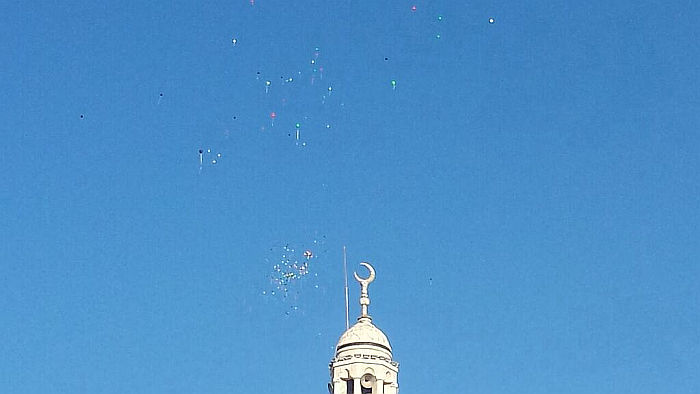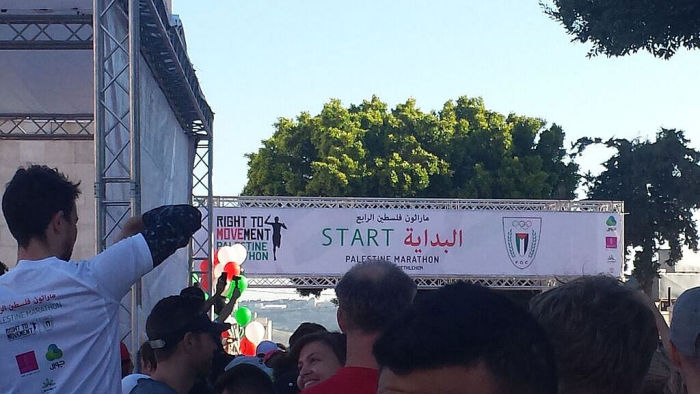 Like an endless game of ping-pong, the cars chug the couple of kilometres from Manger Square to the checkpoint and back again. As our hotel owner’s wife informed us with a weary shrug, “They have nothing else to do. They want to bring their families out on a Saturday evening, so they drive up and down from the square to the checkpoint. They can’t go any further.”
Like an endless game of ping-pong, the cars chug the couple of kilometres from Manger Square to the checkpoint and back again. As our hotel owner’s wife informed us with a weary shrug, “They have nothing else to do. They want to bring their families out on a Saturday evening, so they drive up and down from the square to the checkpoint. They can’t go any further.”
“They” are Palestinian Arabs living in Bethlehem. After the start of the first Iraq war, in 1991, Israel imposed a system of military issued permits on Palestinians seeking to enter Israel or move between the West Bank, East Jerusalem, and Gaza. Those who succeed in securing a permit have their information stored in the biometric access control system (BASEL), which is installed in major Israeli checkpoints in the occupied West Bank and is used to grant or deny Palestinian movement across checkpoints inside the West Bank.
 So Saturday night fun for Bethlehem residents without permits revolves around driving to the separation wall and back to Manger Square, that near-mythical spot recreated with dolls and dish cloths in nativity plays across the world each Christmas. We sat in the window of a restaurant, feasting on hummus and falafel and watching the procession of cars, everything from ancient bangers rumbling along in a clatter of dust and prayers to new model Mustangs and a cherry-red open-top BMW driven by a teenager who waved like a passing monarch. “He stole the keys while his father slept,” sneered our luxuriantly mustachioed restaurant manager.
So Saturday night fun for Bethlehem residents without permits revolves around driving to the separation wall and back to Manger Square, that near-mythical spot recreated with dolls and dish cloths in nativity plays across the world each Christmas. We sat in the window of a restaurant, feasting on hummus and falafel and watching the procession of cars, everything from ancient bangers rumbling along in a clatter of dust and prayers to new model Mustangs and a cherry-red open-top BMW driven by a teenager who waved like a passing monarch. “He stole the keys while his father slept,” sneered our luxuriantly mustachioed restaurant manager.
We hobbled back to our hotel—well, I hobbled, crutch-bound by my stress fracture. Things kicked off later, after a Real Madrid-Barcelona match, which pumped up the energy in that tiny space until it cracked open with the smell of burned rubber and the shots of fired-up engines as the cars did doughnuts on the main street until the police appeared. Our hosts told us that this is a regular occurrence: Families are divided along team lines, so matches between the Spanish soccer giants can set off manic scenes, as tension escapes in a fury of revved engines.
Otherwise, we found Bethlehem an unexpectedly cheerful and friendly place, although, given that we were there for the Palestine Marathon, there was something of a carnival atmosphere anyway. The event offers the only course I know that is itself a political statement: The fact that that land in Palestine is so limited and fragmented, the only way to construct a course is to make runners run the same route four times.
 We gathered in Manger Square on the morning of the race, dance versions of Adele and Justin Bieber pounding as announcements rang out in English and Arabic, and balloons of green, white, red, and black drifted high above the mosque and disappeared in a flawless blue sky. Atmospheres at the start of races are often tense, expectant, charged with the energy of a thousand GPS watches being synchronized, but this was different. Joy and excitement radiated through the crowd of 4,371 participants, most of them signed up for the 10km event, many of them swathed in winter coats and burkas, their race numbers barely visible amid the layers. Once the race started, they swarmed down the street like kids let out from school, many of them gasping and panting before they got to the bottom of the hill. But it didn’t matter; they were not there to win.
We gathered in Manger Square on the morning of the race, dance versions of Adele and Justin Bieber pounding as announcements rang out in English and Arabic, and balloons of green, white, red, and black drifted high above the mosque and disappeared in a flawless blue sky. Atmospheres at the start of races are often tense, expectant, charged with the energy of a thousand GPS watches being synchronized, but this was different. Joy and excitement radiated through the crowd of 4,371 participants, most of them signed up for the 10km event, many of them swathed in winter coats and burkas, their race numbers barely visible amid the layers. Once the race started, they swarmed down the street like kids let out from school, many of them gasping and panting before they got to the bottom of the hill. But it didn’t matter; they were not there to win.
I followed behind on the crutch, glad of the surrounding crowds so that I could plod along without fear of getting lost. I had no clear intention at that stage; I certainly was not going to complete the marathon, but I wanted to complete as much of the course as I could before the heat and hobbling became too much. At about the 4km mark, I came to a section of the course lined with abandoned houses on one side and the illegal separation wall on the other. It is a grim barrier of concrete slabs rising 25 feet into the air, its length emblazoned with graffiti and punctuated with descriptions of isolation, like Stations of the Cross. I turned at the 5km point and negotiated my way back to the hotel. Bethlehem would certainly win no prizes for accessibility: Wheelchairs are unsurprisingly absent, given that even the shortest journey seems to involve flights of steps, paths inexplicably ending beside busy roads, and pavements blocked by parked cars or riddled with holes.
 When I got back to the hotel, I downed the Turkish coffee that our host offers at every opportunity and clapped and cheered runners on their third round of the route. Their faces and bodies were slick and haggard from the baking heat of the furthest point of the course, high in the open plains of the outskirts of the city, where the residents of two refugee camps eke out an existence. I heard afterward that, whereas the kids held out their palms for high fives and ran alongside the runners on the first leg of the marathon, by the time the runners were leaving the camps behind for the final time, the bored children were firing rotten fruit and pebbles.
When I got back to the hotel, I downed the Turkish coffee that our host offers at every opportunity and clapped and cheered runners on their third round of the route. Their faces and bodies were slick and haggard from the baking heat of the furthest point of the course, high in the open plains of the outskirts of the city, where the residents of two refugee camps eke out an existence. I heard afterward that, whereas the kids held out their palms for high fives and ran alongside the runners on the first leg of the marathon, by the time the runners were leaving the camps behind for the final time, the bored children were firing rotten fruit and pebbles.
Alan finished the half marathon and we wandered around Manger Square, milling with delighted finishers wearing olive-wood medals and munching dates. It was chaos, but a joyful chaos for the residents who, unlike us, do not have the choice to be anywhere else.
We will return.
Story? Still doing Hardman?
LikeLike
It is in the lap of the gods right now. I’m still not running, but swimming going well and cycling – well, it’s going… Shall try a gentle jog this weekend and if all my bones remain intact, the Hardman is still a possibility. Thank God, it doesn’t get dark until late in August!
LikeLike
Well that’s okay then. I thought I was going to have to do the damn thing on my own!
LikeLike
I think I’ll be the one doing it on my own – in the dark!
LikeLiked by 1 person